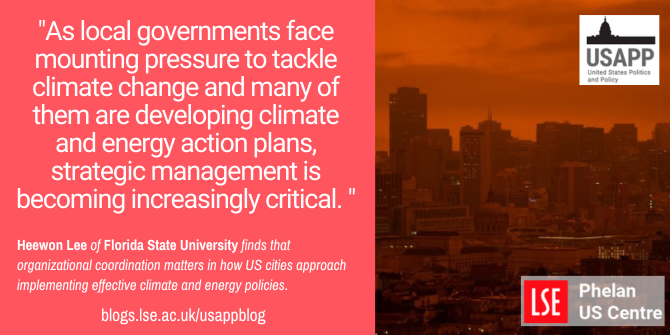 In new research Heewon Lee looked at survey data from over 500 US cities to identify how they implemented energy action policies and sustainability initiatives to address climate change. She finds two patterns in energy policy implementation across cities: some adopt a “prospector” approach, which brings together energy goals across policy areas; while others take a “defender” approach and focus on one or two policy areas. In both cases, organizational capabilities and administrative coordination matters for successful policy implementation.
In new research Heewon Lee looked at survey data from over 500 US cities to identify how they implemented energy action policies and sustainability initiatives to address climate change. She finds two patterns in energy policy implementation across cities: some adopt a “prospector” approach, which brings together energy goals across policy areas; while others take a “defender” approach and focus on one or two policy areas. In both cases, organizational capabilities and administrative coordination matters for successful policy implementation.
To reduce greenhouse gas emissions and meet climate change goals, local governments in the United States are taking a front-line role in building sustainable communities. They have integrated energy policy goals across different areas of their work, experimented with community-wide energy actions and government managerial practices, and recognized the need for strategic planning to mitigate and adapt to climate change. Cities in the US exhibit different patterns when expanding their energy action portfolios. Some diversify across multiple domains and integrate energy goals across policy domains of electricity energy efficiency, fuel efficiency, and renewable energy generation, while others focus on one or two areas and stack multiple actions. In new research, I analyzed survey data on the sustainability practices of 543 US cities to identify factors that influence these implementation patterns.
Cities integrate climate change goals across policy areas and implement extensive energy actions
I identified 15 energy actions that are commonly implemented by local governments and categorized them into domains of energy efficiency in government, energy efficiency in the community, fuel efficiency and alternative fuels, and alternative energy. City governments make energy conservation efforts in their own operations and asset management, by adopting energy efficiency goals in public facility operation, construction, and procurement practices, which were most frequent among all actions. Further, city governments often carry out community-wide energy efficiency initiatives. Community-wide strategies to conserve energy are likely to improve or replace infrastructure of water supply, transportation systems, or city landscape. In addition, cities procure fuel-efficient or alternative fuel vehicles and deploy alternative fueling infrastructure. Lastly, cities increase energy generation using carbon-free sources such as solar, wind, and thermal energy.
Figure 1 – Energy policy actions of US cities

Note: The figure summarizes energy policy actions implemented in 543 cities, and the frequency of each action. Source: 2015 Local Government Sustainability Practices survey, International City/County Management Association (ICMA).
Cities can be ‘prospectors’ or ‘defenders’ on energy policy
I found two distinct patterns in energy policy implementation across cities. Some cities adopt a “prospector” approach, integrating energy goals into multiple policy domains, including electricity energy efficiency, fuel efficiency, and renewable energy generation. Others take a “defender” approach, focusing on one or two policy areas. Figure 2 shows that at least one energy policy action has been implemented in all cities studied, with 65 cities implementing all actions within a single policy domain. Of these 65 cities, 26 have implemented between two and six actions in the same policy areas. These cities commit to a specific policy domain, such as energy efficiency in the government or community, and stack policy actions to improve efficiency and reduce uncertainty in their energy transitions. The variation in implementation strategies across cities highlights the need for a closer examination of strategic approaches to energy policy implementation. By understanding the different approaches and their outcomes, effective practices, and strategies for achieving energy goals in cities can be identified.

Photo by Patrick Perkins on Unsplash
Figure 2 – Distribution of energy policy action

Note: n=543. Source: 2015 Local Government Sustainability Practices survey, International City/County Management Association (ICMA).
Resources and capabilities for successful integration of climate change goals
Different patterns of implementing energy policy actions, either as prospectors or defenders, are associated with unique resources and capabilities. Public managers weigh the benefits and costs of allocating resources and building capabilities to carry out each energy action. From a strategic management perspective, local governments make distinct decisions regarding organizational structure, resource allocation, and information processing to implement strategies and pursue their climate change mitigation goals.
To determine whether a city is a prospector or defender and to measure the degree of exploration or concentration, I used an index which measures whether a city’s energy policy actions are spread across multiple domains or concentrated in specific areas – known as an entropy index. Higher prospector entropy indicates more exploration in the energy policy portfolio, whereas higher defender entropy signifies a narrower focus.
The importance of administrative coordination for integrating climate change goals
Regarding organizational capabilities, administrative coordination among departments within city governments is critical for both prospectors and defenders. Both integrating climate change goals in different energy policy areas and stacking policy actions in one policy area, require overcoming organizational silos and restructuring. In terms of organizational resources, financial resources are beneficial for both types. On the other hand, dedicated staff are positively associated with defenders but not with prospectors. The results suggest that staff members with specialized knowledge in energy actions are more likely to focus on a specific energy policy domain, and their expertise may not be as easily transferable to other categories of energy actions.
As local governments face mounting pressure to tackle climate change and many of them are developing climate and energy action plans, strategic management is becoming increasingly critical. While each city may face distinct pressing challenges, taking a comprehensive and holistic approach is crucial for long-term success. My research offers insights into how cities can seamlessly integrate policy objectives across diverse energy policy domains, ultimately reducing greenhouse gas emissions and achieving their climate goals. Additionally, the study highlights the essential resources and capabilities needed for successful implementation.
- This article is based on the paper, ‘Strategic types, implementation, and capabilities: Sustainability policies of local governments’, in Public Administration.
- Please read our comments policy before commenting.
- Note: This article gives the views of the author, and not the position of USAPP – American Politics and Policy, nor the London School of Economics.
- Shortened URL for this post: https://bit.ly/3P0cKHg






